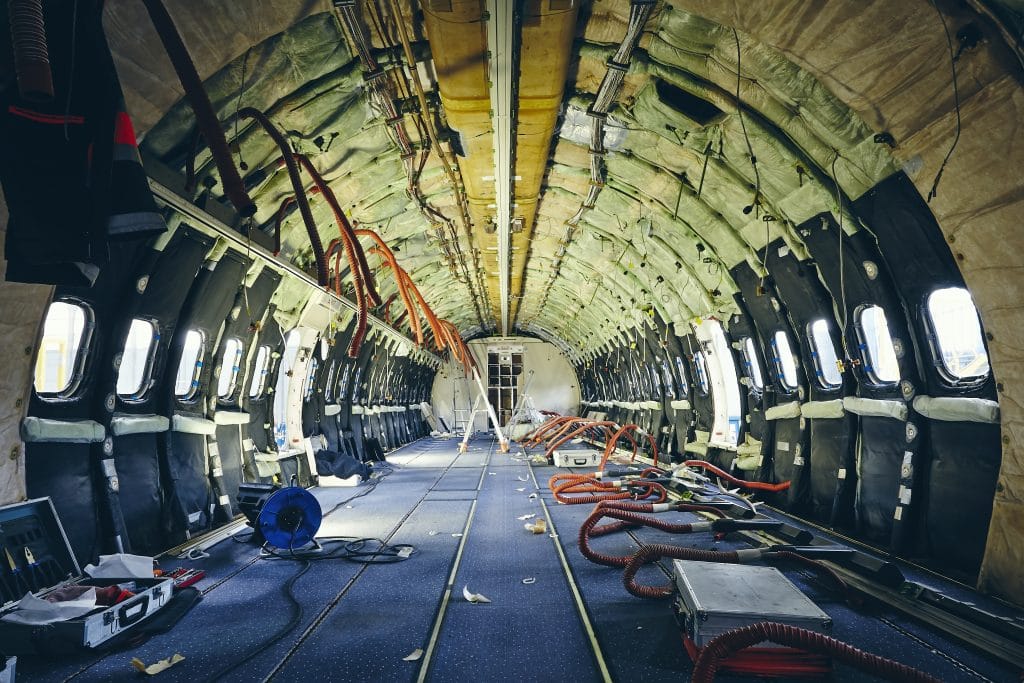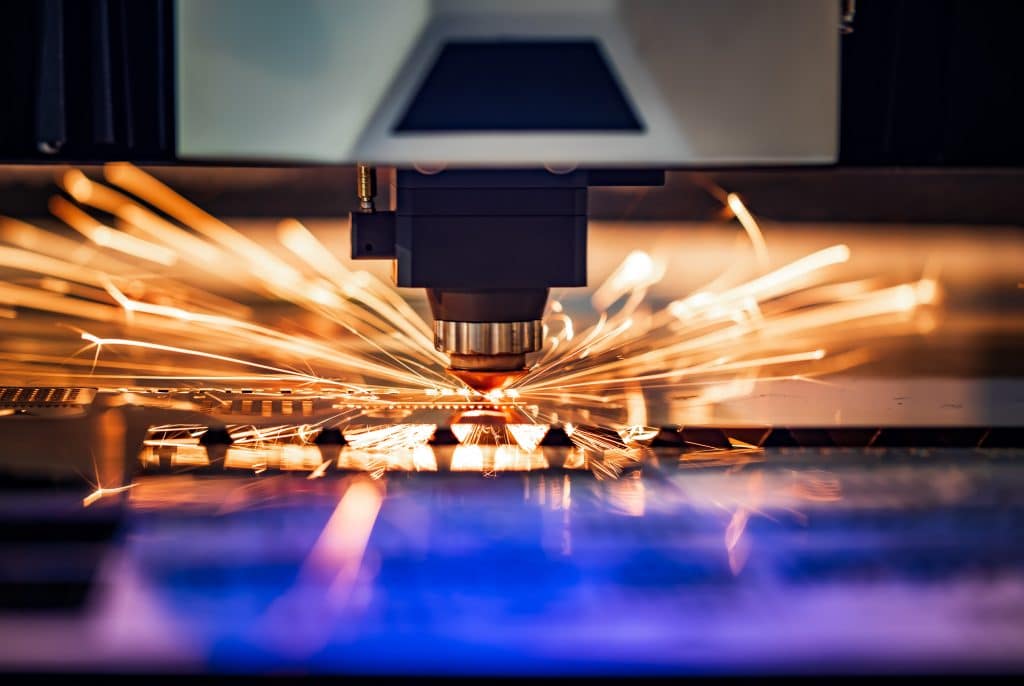Aerospace equipment maintenance refers to maintaining the aircraft and support equipment (SE) to make sure the continuing safety of an aircraft or parts of aircraft. This task includes defect rectification, inspection, overhaul, and replacement, compliance with the airworthiness directives, and modifications embodiment.
In the aviation industry, a very crucial issue is the maintenance of aerospace equipment. Very large and complex regulatory agencies and network management have to operate flawlessly, on-time, and detect-free delivering parts to all corners of the world.

Interior of the commercial airplane under heavy maintenance. Safety, control and aerospace industry.
To keep the operations of fleets safe and cost-effective, the airlines rely on the vast and ever-growing system of repair stations. The evolution and development of maintenance programs take place with every new type of aircraft based on experience with similar components, engines, materials, and structures.
Because of limited experience, the new structures or materials are more frequently observed until the basic confidence level is achieved. The extension in time to the inspection interval is given based on observations made during the regular service checks.
There are two types of equipment that require servicing, storage, repair, and maintenance. These are powered units and non-powered units. For the facility, the space requirement is determined by the type and quantity of the aerospace laboratory equipment.
Why Maintenance of Aerospace Equipment is Needed?
The objectives of effective aerospace equipment maintenance are as follows:
- The maintenance activity ensures the inherent airworthiness, reliability, and sustainability of aircraft design.
- To restore the reliability and safety levels when deterioration happens by providing opportunities
- When the inherent reliability is inadequate, then information regarding design modification is obtained.
- Ensure the condition, maintenance, and calibration of aerospace laboratory equipment.
- To support the efficient and airworthiness operation of the aerospace equipment by earlier detection of defects.
- Achieving the above-mentioned task at a minimal cost.
Structural Maintenance
To program any new aircraft, it is based on the assessment of the information on structural design, valid test results, damage and fatigue tolerance evaluations, and service experience with similar structure aircraft.
Generally, the purpose of maintenance task is to structural deterioration sources such as fatigue damage, accidental damage, environmental deterioration, structural deterioration consequences for continuing working order including the effect on an aircraft (e.g. Decline in residual strength, function loss, multiple-element and multiple-site fatigue damage, failure to power plant, structural damage interactions which cause the effect on response characteristics or aircraft flight), effectiveness and applicability of structural deterioration detection methods by taking into account the repeat intervals and inspection threshold.
Component Maintenance
If the aircraft designer is acquainted with the component experience, then too much maintenance, hardship, and difficulties apply to 1+ the new material. The reliability of the aircraft’s hardware component or part, if supported by proper maintenance, is well as its inherent design tolerates it to be.
This indicates that to reach potential reliability requires good maintenance, reliability degrades due to under-maintaining, and also reliability is not improved by over-maintaining. Hence, basic design changes are required to tackle the inherent component reliability issues.
For preventive maintenance, there are three proven and effective approaches:
- The first approach is to remove a service unit when its pre-ordained parameter value reaches.
- The second is the functional inspection or check, which involves usage of a hardware part to determine if that piece is fit for continued working or to avoid in-service failure, the hardware piece should be removed.
- The third approach is functional verification, which means to determine the availability of each function by carrying out an operational check of the hardware function(s).
For many hardware parts, hidden function verification, deterioration measurements are not beneficial or economically feasible. Such parts or components need routine reliability and performance check.
Due to increased redundancy in the design, modern aircraft are more failure tolerant as compared to the older ones. Component maintenance tasks are classified as follows:
- Functional or inspection check, where it is detectable to reduce the resistance to failure, and the reduction rate is predictable in resistance failure.
- Visual or inspection check, where it is possible to identify the failure.
- Serving or lubrication, where the consumable replenishment minimizes the functional deterioration rate.
- Discard when an item at the identifiable age shows the characteristics of functional degradation.
Service Experience
Potential degradation or damages in the operating environments must be considered by the designer as it is required when commercial aircraft have experimented with new materials.
In addition to that, develop repair and maintenance approaches to cater to them. Aircraft servicing and operation activities, environmental and thermal cycles, and flight loads cause damages.
Ramp and Maintenance Damages
Airlines have to bear the high cost in case of ramp and maintenance damages. The repairing of the damaged component has just been a part of the total cost; with that, the airline also bears cancellation or the flight delay cost and damage effects on aircraft rotation and connections.
Best Practices in Aging Aircrafts
Aloha Airlines Boeing 737-200 went through an in-flight structural failure in April 1988. The upper fuselage of the plane ripped open and was detached from the aircraft.
Multiple-side damage, in this case, was a link-up of fatigue cracks which drawn-out from the adjacent rivet holes in the longitudinal joint in the fuselage. This accident grabbed the international attention of commercial fleet aging issues.
The emphasis on the MSD, corrosion, fatigue, and stress corrosion issues are increased throughout the review of experience with the aging aircraft. In turn, this experience gives a realization to select alloys with better treatment of heat tempers and control of constituent chemistry for new aircraft.

CNC Laser cutting of metal, modern industrial technology. Small depth of field. Warning – authentic shooting in challenging conditions.
This experience also stimulated to develop new organic finishes that retard corrosion significantly; also, to enhance corrosion resistance the design practices are vastly implemented.
Many aging aircraft designs are capable of useful and safe operation in today’s environment and have manufacturers that no longer exist or are out of business. Other manufacturers that possibly exist are not able to provide field sustenance for the aging aircraft models.
Maintenance procedures, engineering drawings, and various other technical data are not available now from these non-supportive and or non-existent manufacturers.
To improve the likelihood of safe operation and maintenance of particular aircraft depends on the acquisition, preservation, organization, and easy availability of access to the related data.
These practices can have a huge impact on the safe operation of the small aging airplane of numerous model types in the future.
There are specifically two best practices that can have an ultimate effect on how the inspection and maintenance are approached for the aging airplane fleet. These are special attention inspections and airplane record research.
Utilizing either of the two approaches helps assess the airplane condition. To assess thoroughly the airplane aging effects requires the application of both approaches and provide a condition monitoring method as the airplane continued to age.
Airplane Record Research
To determine the aging airplane condition, record research is the first step. The degree of necessary inspection and with the help of thorough record research, it becomes convenient to determine what items are inspected already.
The record research will also help to identify certain usage and maintenance characteristics of an airplane, but will also expose the potential attention to pertinent areas to a usage class and model type.
Usually, the overhaul and inspection recommendations available in older general aviation airplane maintenance instructions are not enough to guide regarding aging airplane maintenance issues.
Therefore, it is necessary to determine which airplane parts are replaced when assessing the maintenance, quality of during the aircraft’s life. For example, if corrosion was ever a problem that can lead to aging issues.
The airplane owner and mechanic must collect all the information available to organize the maintenance history of any specific aircraft. This helps in establishing a standard to determine alterations, repair, and maintenance that has been practiced and how well that aircraft has been maintained.
To identify the differences and similarities, the research from more general issues regarding the model type can be compared with the information on individual planes. Below are some sources that must be used to determine the history of model type and/or airplane individually.
- Logbook Entries: Traditionally, the mechanics and owners start their investigations from logbooks. Having a logbook is a plus because they provide a complete back to when the aircraft came from the production.
But this is not possible for various reasons such as destroyed, theft, etc. because of this record acquisition is important. Logbook tells the clear trend of the maintenance performed throughout the airplane’s life as well as its usage history.
The clear indications of compliance with the airworthiness directive, as well as the major repairs and modifications done must be mentioned there.
If the logbook shows some alteration or maintenance actions that are not part of the aircraft, then to find the missing action further investigation may be done. Similarly, if there is no entry in the logbook of any alteration then investigate the alterations to know their effect on airplane performance.
- Aircraft Records: The aviation administration provides the specific engines and propeller records of the aircraft. By sending the request to aviation administration by mentioning an N number of aircraft, the owner can get the information of all the records and data on that specific aircraft.
But N number can be changed so the aircraft model and serial number must be mentioned in the request. If the information does not match, further investigation is needed.
The available records include bills-of-sale, modifications, repair, and registration of STC certificates. The information on paper can be checked on the airplane physically to confirm that there are no unrecorded alterations.
- Type Certificate Data Sheets (TCDS): This certificate contains the data specific to the model type. It is the summary of the technical description of the baseline of the model type. This description tells about the weights, performance, the center of gravity limitations, propeller, and engine specifications.
- Airworthiness Directives (AD): The owners of affected aircraft have issued Airworthiness Directives containing engines, model types, appliances, or propellers information, which is issued by aviation administration. To correct the risky condition of the airplane, the AD action is mandatory. Usually, the required actions include modifications, repetitive or one-time inspections or both.
Special Attention Inspections
Paperwork assessment of an aircraft has been just an introduction to a thorough evaluation of aging. The normal annual inspection is not enough for aging aircraft. A detailed or series of inspections, parts replacement, modifications, or their combinations are necessary to keep the safe operation of an aging airplane.
The inspection techniques and methods also change from previous requirements as airplane ages. Because of high aircraft time, inactivity, severe operation, poor maintenance, modifications, or outside storage. To pertain to a specific airplane type, special inspection criteria can be written.
The design concept of structures (material and layout) and systems (flight controls, electrical, and mechanical) is alike from manufacturer to manufacturer and model to model for most of the aging GA airplanes.
The areas susceptible to aging and critical to the airworthiness of an airplane are General, Engine, Modifications, Avionics Fuel, System, Propeller, Controls, Fuselage, Repairs, Electrical, Instruments, Systems, Empennage, Landing, Gear, and Wing.
Some of these areas are sensitive to the calendar age, such as control cables, electrical connectors, fuel, seals, hydraulic pumping, wiring, and corrosion. Other areas are corrosion or flight hours sensitive.
This includes major attach fittings like engine attachments, empennage, and wing. For instance, the component that is typically never inspected or removed are attach bolts.
In addition to that, the checklist form should be expanded by the airplane mechanic or owner to include items that come from the record research and are of special concern.
Manufacturer service letters and modifications usually provide instructions about performing modifications or particular inspections such as eddy current, dye penetrant, magnifying lens, visual, etc. with special instructions.
So when available, attach or include this data in the form of the modifications or inspections that are independently developed.
The maintenance practices described in this article should be applied to get safety benefits. Keeping and organizing inspection documentation and record research increases the airplane or aircraft value, and future inspections become easier and prevent potential risks.
